Manjoro kde双系统的踩坑之路
本来打算是想在虚拟机里面玩玩这个系统,但是觉得虚拟机玩着没那个意思。于是自己就打算搞个双系统。这几天在这里面踩了好多坑。唉,搞到最后,发现其实还不如在windows上,做开发用真的足够了,但是我挺烦这个开机贼慢和进桌面都会黑屏的问题。另外自己,有许多搞嵌入式的在linux上实在没有。所以我打算写完这篇文章后继续回到我的Windows。相信linux系统的未来会更好。略有些遗憾告别了这个系统。
1:下载镜像
首先第一步,去Manjoro官网下载镜像。镜像的话这里是有三个版本,第一个版本是xfce,第二个版本是kde版本的,第三个gnome.然后我觉得kde版本的比较友好吧。而且功能比较强大,里面我觉得最好的一个软件就是kdeconnect,这个软件真的好用,可惜windows没有类似的软件。
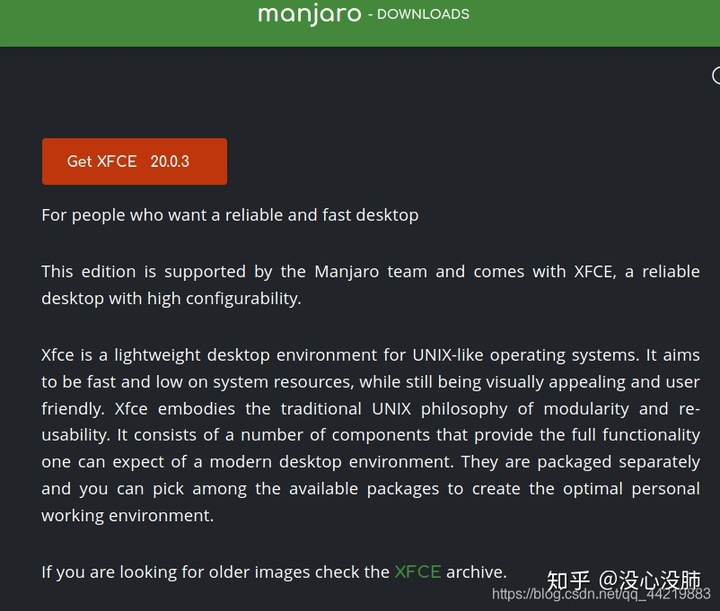


以上就是三个版本的,下载镜像即可,但是由于服务器在国外的原因,速度很慢,这里我把百度云链接放到这,需要的自取:链接: https://pan.baidu.com/s/14ywNtYmKfcvZ4jP760WNQA 提取码: fy4d 。
2:分出一个磁盘并且烧录镜像进去
目前主流的两种启动系统的方式: *legacy*启动+MBR分区表
*UEFI*启动+*GPT*分区表
这里我们需要先分出一个磁盘,分盘的操作大家应该都没啥问题,所以这一步直接省略了。右键选择一个磁盘->属性->卷,在磁盘分区形式一栏中可以看到是GPT or MBR,这里的话我们要记住了,一会rufus设置的要用的到
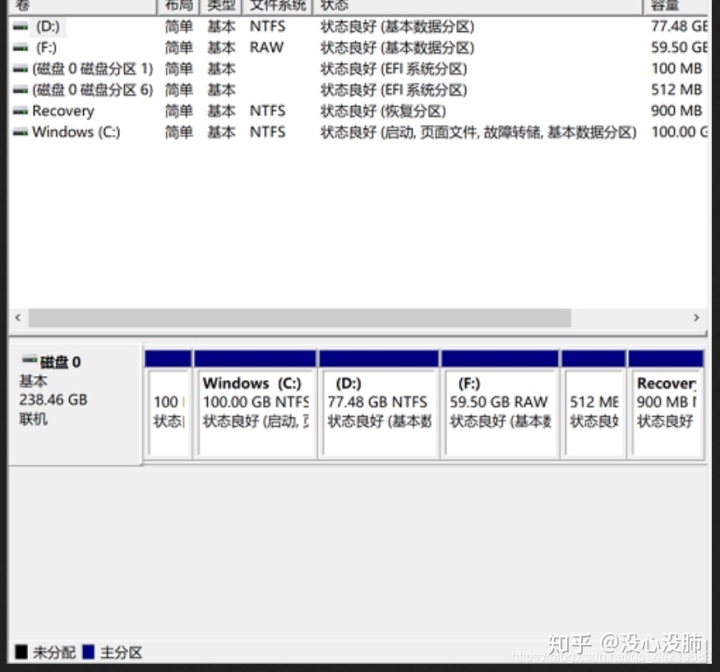
烧录镜像的有俩个软件可以选择,一个是rufus,另一个win32diskimage把,具体我也忘了,rufus下载的链接为:http://rufus.ie/。打开后是这个页面:
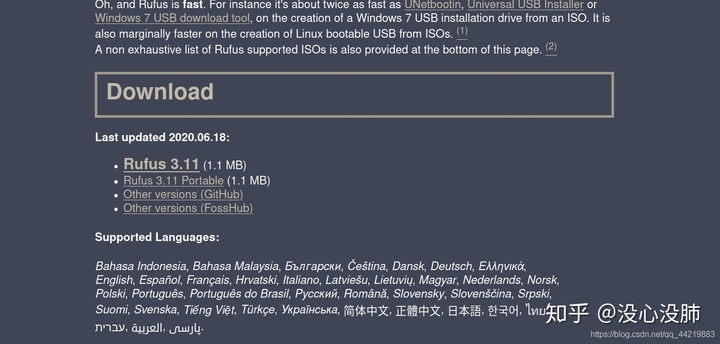
这里选择other version,然后括号里面github和fosshub无所谓。下载版本一定选择3,4的。否则gpt分区没法选择。

插入u盘,打开Rufus,我的分区类型一栏选择的是GPT,其他的都为默认,
点击开始后弹出该窗口,点击以DD镜像模式写入:
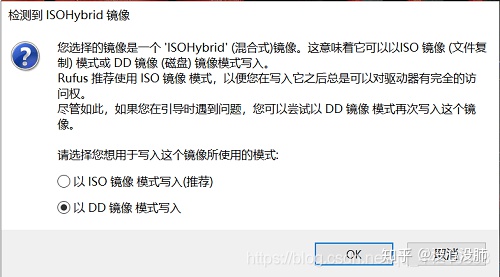
3 配置系统以及安装manjoro
然后正常装系统操作,这个就不写了,之后会一步步进入到安装引导界面。如下图所示:

lang =en_us这一行的话可以设置下语言,其余保持默认即可。然后切到Boot那一行按回车即可。
接下来就回来到下一个界面。
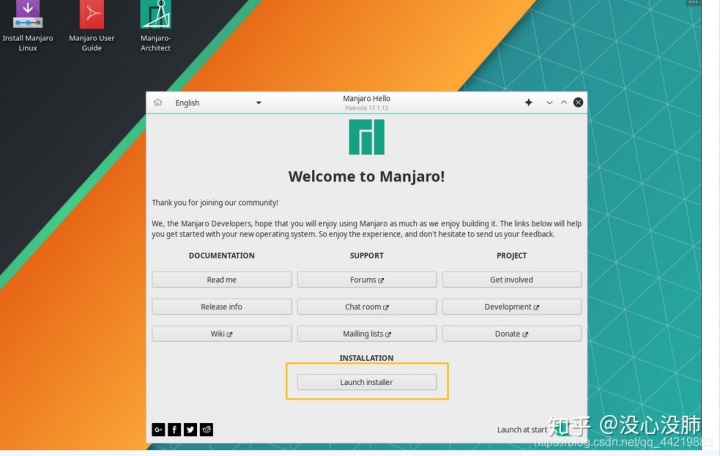
在这个界面先连下网,然后点击黄框选中的,开始一步步傻瓜式安装,接下来几幅图就是对应的:
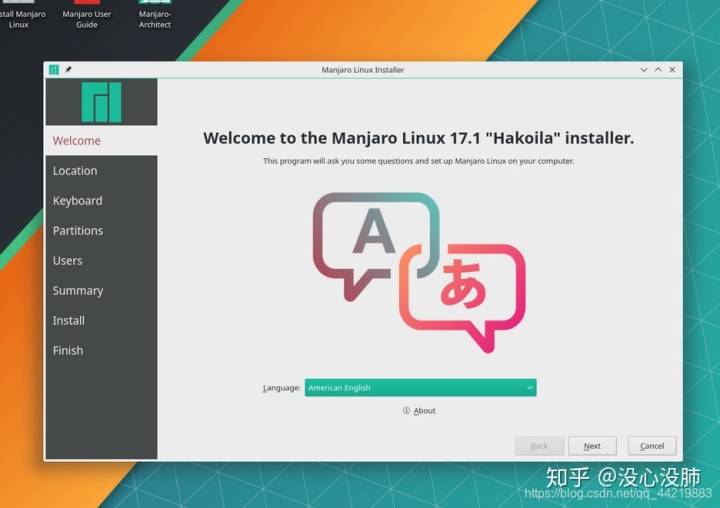


分区的话选择自动替换一个分区就可以。记得分区选择我们之前分出那个区域。让manjoro帮我们自动分区。
接下来设置账户信息,这个就不用多说了吧,设置好以后就下一步就行咯。
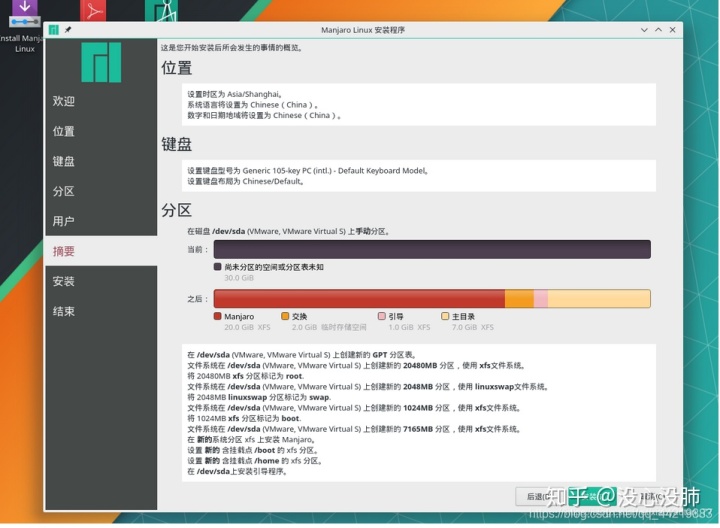
最后会让你确认一下是否正确。没啥错误就点击安装就好了。
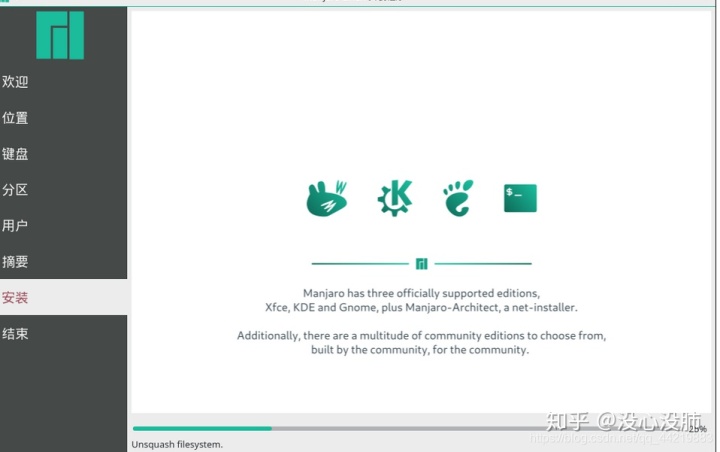
之后等待进度条走完,然后选择重启,拔掉u盘。剩下的就可以开心的配置Manjoro了。
4:调节字体以及安装各种常用软件
1 换源
首先需要进行的第一步就是换源。
换源的俩条指令,依次输入命令即可:
sudo pacman-mirrors -i -c China -m rank
sudo pacman -Syy第一条指令输入后会显示几个速度快的源,这里都选上即可。然后再输入第二条指令。
之后输入指令 :sudo nano /etc/pacman.conf
在文件最后一行加入:
[archlinuxcn]
SigLevel = Optional TrustedOnly
Server = https://mirrors.ustc.edu.cn/archlinuxcn/$arch然后ctrl+x退出,点击Y,回车保存即可。
之后输入指令 :
sudo pacman -Syy
sudo pacman -S archlinuxcn-keyring2:安装各种常用软件
首先安装下中文输入法,这里的话搜狗显然是更加好用的,
首先安装yay,这个可以pacman去安装软件:
sudo pacman -S yay base-devel
yay -S fcitx-qt4 kcm-fcitx fcitx-sogoupinyin
sudo echo -e "export GTK_IM_MODULE=fcitxn export QT_IM_MODULE=fcitxn export XMODIFIERS=@im=fcitx" >>~/.xprofile依次输入上面俩条指令,然后reboot重启。
谷歌浏览器:
sudo pacman -S google-chrome安装完后可以把火狐卸了。谷歌安装插件的方法和windows上没有区别,依旧是.crx文件往里面拖就好。
git,VScode:
sudo pacman -S git
sudo pacman -S visual-studio-code-bin网易云音乐:
yay -S netease-cloud-music安装的软件通病都是字体不会跟随系统字体而变化,这一点我觉得很不舒服,还要自己来配置。
安装:tim
yay -R deepin-wine-tim
安装之后可能出现闪退的现象,这时候输入以下指令:
sudo pacman -S gnome-settings-daemon
设置/usr/lib/gsd-xsettings为自启动
系统设置->开机或关机->自动启动->添加脚本->输入/usr/lib/gsd-xsettings
重启即可打开tim界面也可能会出现字体极小的现象。这时候不要慌,输入以下指令,也就是调节wine的dpi设定:
env WINEPREFIX="$HOME/.deepinwine/Deepin-TIM" winecfg设置显示界面的dpi即可,也就是吧dpi的数值调大即可。

之后就显示正常了,very good!!!。
安装截图工具并设置快捷:
这里推荐flameshot.
输入代码:sudo pacman -S flameshot
之后在系统设置全局快捷键:

这里右键选择新建-全局快捷键-命令(URl)。快捷根据自己习惯设置,动作输入:flameshot gui ,然后应用保存即可。
安装typora:
sudo pacman -S typora
3:字体设置:
网易云界面字体的设置方法:
修改 /opt/netease/netease-cloud-music下的netease-cloud-music.bash
最后一行添加上:
--force-device-scale-factor=1.8即可。
然后系统字体我调节的大小大概是14像素:
缩放调节的120%.感觉看的才比较舒服一点。
4 美化界面:
1安装latte-dock栏:
输入以下指令:
sudo pacman -S latte-dock关闭背景大小 绝对大小48 鼠标悬停放大40% 删除模拟时钟 在dock上添加部件 左侧为应用程序面板 右侧为回收站
之后自己配置dock栏就可以了。
2安装zsh
输入下面这条指令安装git.之后会用到git。
sudo pacman -S git接下来输入以下指令:
sh -c "$(curl -fsSL https://raw.githubusercontent.com/robbyrussell/oh-my-zsh/master/tools/install.sh)"如果出现404那就是网络原因,自己可以在桌面建立一个install.sh.内容如下:
#!/bin/sh
#
# This script should be run via curl:
# sh -c "$(curl -fsSL https://raw.githubusercontent.com/ohmyzsh/ohmyzsh/master/tools/install.sh)"
# or wget:
# sh -c "$(wget -qO- https://raw.githubusercontent.com/ohmyzsh/ohmyzsh/master/tools/install.sh)"
#
# As an alternative, you can first download the install script and run it afterwards:
# wget https://raw.githubusercontent.com/ohmyzsh/ohmyzsh/master/tools/install.sh
# sh install.sh
#
# You can tweak the install behavior by setting variables when running the script. For
# example, to change the path to the Oh My Zsh repository:
# ZSH=~/.zsh sh install.sh
#
# Respects the following environment variables:
# ZSH - path to the Oh My Zsh repository folder (default: $HOME/.oh-my-zsh)
# REPO - name of the GitHub repo to install from (default: ohmyzsh/ohmyzsh)
# REMOTE - full remote URL of the git repo to install (default: GitHub via HTTPS)
# BRANCH - branch to check out immediately after install (default: master)
#
# Other options:
# CHSH - 'no' means the installer will not change the default shell (default: yes)
# RUNZSH - 'no' means the installer will not run zsh after the install (default: yes)
# KEEP_ZSHRC - 'yes' means the installer will not replace an existing .zshrc (default: no)
#
# You can also pass some arguments to the install script to set some these options:
# --skip-chsh: has the same behavior as setting CHSH to 'no'
# --unattended: sets both CHSH and RUNZSH to 'no'
# --keep-zshrc: sets KEEP_ZSHRC to 'yes'
# For example:
# sh install.sh --unattended
#
set -e
# Default settings
ZSH=${ZSH:-~/.oh-my-zsh}
REPO=${REPO:-ohmyzsh/ohmyzsh}
REMOTE=${REMOTE:-https://github.com/${REPO}.git}
BRANCH=${BRANCH:-master}
# Other options
CHSH=${CHSH:-yes}
RUNZSH=${RUNZSH:-yes}
KEEP_ZSHRC=${KEEP_ZSHRC:-no}
command_exists() {
command -v "$@" >/dev/null 2>&1
}
error() {
echo ${RED}"Error: $@"${RESET} >&2
}
setup_color() {
# Only use colors if connected to a terminal
if [ -t 1 ]; then
RED=$(printf '033[31m')
GREEN=$(printf '033[32m')
YELLOW=$(printf '033[33m')
BLUE=$(printf '033[34m')
BOLD=$(printf '033[1m')
RESET=$(printf '033[m')
else
RED=""
GREEN=""
YELLOW=""
BLUE=""
BOLD=""
RESET=""
fi
}
setup_ohmyzsh() {
# Prevent the cloned repository from having insecure permissions. Failing to do
# so causes compinit() calls to fail with "command not found: compdef" errors
# for users with insecure umasks (e.g., "002", allowing group writability). Note
# that this will be ignored under Cygwin by default, as Windows ACLs take
# precedence over umasks except for filesystems mounted with option "noacl".
umask g-w,o-w
echo "${BLUE}Cloning Oh My Zsh...${RESET}"
command_exists git || {
error "git is not installed"
exit 1
}
if [ "$OSTYPE" = cygwin ] && git --version | grep -q msysgit; then
error "Windows/MSYS Git is not supported on Cygwin"
error "Make sure the Cygwin git package is installed and is first on the $PATH"
exit 1
fi
git clone -c core.eol=lf -c core.autocrlf=false
-c fsck.zeroPaddedFilemode=ignore
-c fetch.fsck.zeroPaddedFilemode=ignore
-c receive.fsck.zeroPaddedFilemode=ignore
--depth=1 --branch "$BRANCH" "$REMOTE" "$ZSH" || {
error "git clone of oh-my-zsh repo failed"
exit 1
}
echo
}
setup_zshrc() {
# Keep most recent old .zshrc at .zshrc.pre-oh-my-zsh, and older ones
# with datestamp of installation that moved them aside, so we never actually
# destroy a user's original zshrc
echo "${BLUE}Looking for an existing zsh config...${RESET}"
# Must use this exact name so uninstall.sh can find it
OLD_ZSHRC=~/.zshrc.pre-oh-my-zsh
if [ -f ~/.zshrc ] || [ -h ~/.zshrc ]; then
# Skip this if the user doesn't want to replace an existing .zshrc
if [ $KEEP_ZSHRC = yes ]; then
echo "${YELLOW}Found ~/.zshrc.${RESET} ${GREEN}Keeping...${RESET}"
return
fi
if [ -e "$OLD_ZSHRC" ]; then
OLD_OLD_ZSHRC="${OLD_ZSHRC}-$(date +%Y-%m-%d_%H-%M-%S)"
if [ -e "$OLD_OLD_ZSHRC" ]; then
error "$OLD_OLD_ZSHRC exists. Can't back up ${OLD_ZSHRC}"
error "re-run the installer again in a couple of seconds"
exit 1
fi
mv "$OLD_ZSHRC" "${OLD_OLD_ZSHRC}"
echo "${YELLOW}Found old ~/.zshrc.pre-oh-my-zsh."
"${GREEN}Backing up to ${OLD_OLD_ZSHRC}${RESET}"
fi
echo "${YELLOW}Found ~/.zshrc.${RESET} ${GREEN}Backing up to ${OLD_ZSHRC}${RESET}"
mv ~/.zshrc "$OLD_ZSHRC"
fi
echo "${GREEN}Using the Oh My Zsh template file and adding it to ~/.zshrc.${RESET}"
sed "/^export ZSH=/ c
export ZSH="$ZSH"
" "$ZSH/templates/zshrc.zsh-template" > ~/.zshrc-omztemp
mv -f ~/.zshrc-omztemp ~/.zshrc
echo
}
setup_shell() {
# Skip setup if the user wants or stdin is closed (not running interactively).
if [ $CHSH = no ]; then
return
fi
# If this user's login shell is already "zsh", do not attempt to switch.
if [ "$(basename "$SHELL")" = "zsh" ]; then
return
fi
# If this platform doesn't provide a "chsh" command, bail out.
if ! command_exists chsh; then
cat <<-EOF
I can't change your shell automatically because this system does not have chsh.
${BLUE}Please manually change your default shell to zsh${RESET}
EOF
return
fi
echo "${BLUE}Time to change your default shell to zsh:${RESET}"
# Prompt for user choice on changing the default login shell
printf "${YELLOW}Do you want to change your default shell to zsh? [Y/n]${RESET} "
read opt
case $opt in
y*|Y*|"") echo "Changing the shell..." ;;
n*|N*) echo "Shell change skipped."; return ;;
*) echo "Invalid choice. Shell change skipped."; return ;;
esac
# Check if we're running on Termux
case "$PREFIX" in
*com.termux*) termux=true; zsh=zsh ;;
*) termux=false ;;
esac
if [ "$termux" != true ]; then
# Test for the right location of the "shells" file
if [ -f /etc/shells ]; then
shells_file=/etc/shells
elif [ -f /usr/share/defaults/etc/shells ]; then # Solus OS
shells_file=/usr/share/defaults/etc/shells
else
error "could not find /etc/shells file. Change your default shell manually."
return
fi
# Get the path to the right zsh binary
# 1. Use the most preceding one based on $PATH, then check that it's in the shells file
# 2. If that fails, get a zsh path from the shells file, then check it actually exists
if ! zsh=$(which zsh) || ! grep -qx "$zsh" "$shells_file"; then
if ! zsh=$(grep '^/.*/zsh$' "$shells_file" | tail -1) || [ ! -f "$zsh" ]; then
error "no zsh binary found or not present in '$shells_file'"
error "change your default shell manually."
return
fi
fi
fi
# We're going to change the default shell, so back up the current one
if [ -n "$SHELL" ]; then
echo $SHELL > ~/.shell.pre-oh-my-zsh
else
grep "^$USER:" /etc/passwd | awk -F: '{print $7}' > ~/.shell.pre-oh-my-zsh
fi
# Actually change the default shell to zsh
if ! chsh -s "$zsh"; then
error "chsh command unsuccessful. Change your default shell manually."
else
export SHELL="$zsh"
echo "${GREEN}Shell successfully changed to '$zsh'.${RESET}"
fi
echo
}
main() {
# Run as unattended if stdin is closed
if [ ! -t 0 ]; then
RUNZSH=no
CHSH=no
fi
# Parse arguments
while [ $# -gt 0 ]; do
case $1 in
--unattended) RUNZSH=no; CHSH=no ;;
--skip-chsh) CHSH=no ;;
--keep-zshrc) KEEP_ZSHRC=yes ;;
esac
shift
done
setup_color
if ! command_exists zsh; then
echo "${YELLOW}Zsh is not installed.${RESET} Please install zsh first."
exit 1
fi
if [ -d "$ZSH" ]; then
cat <<-EOF
${YELLOW}You already have Oh My Zsh installed.${RESET}
You'll need to remove '$ZSH' if you want to reinstall.
EOF
exit 1
fi
setup_ohmyzsh
setup_zshrc
setup_shell
printf "$GREEN"
cat <<-'EOF'
__ __
____ / /_ ____ ___ __ __ ____ _____/ /_
/ __ / __ / __ `__ / / / / /_ / / ___/ __
/ /_/ / / / / / / / / / / /_/ / / /_(__ ) / / /
____/_/ /_/ /_/ /_/ /_/__, / /___/____/_/ /_/
/____/ ....is now installed!
Before you scream Oh My Zsh! please look over the ~/.zshrc file to select plugins, themes, and options.
• Follow us on Twitter: https://twitter.com/ohmyzsh
• Join our Discord server: https://discord.gg/ohmyzsh
• Get stickers, shirts, coffee mugs and other swag: https://shop.planetargon.com/collections/oh-my-zsh
EOF
printf "$RESET"
if [ $RUNZSH = no ]; then
echo "${YELLOW}Run zsh to try it out.${RESET}"
exit
fi
exec zsh -l
}
main "$@"然后cd切换到桌面上,输入指令:
sh install.sh3:安装PowerLevel10k主题
依次运行以下命令
#安装字体
sudo pacman -S nerd-fonts-complete
#安装powerlevel10k主题
sudo pacman -Sy --noconfirm zsh-theme-powerlevel10k
#配置powerlevel10k
echo 'source /usr/share/zsh-theme-powerlevel10k/powerlevel10k.zsh-theme' >>! ~/.zshrc
#使配置立即生效
source ~/.zshrc4 :安装自动补全插件
git clone git://github.com/zsh-users/zsh-autosuggestions $ZSH_CUSTOM/plugins/zsh-autosuggestions运行以下命令更改配置
sudo nano ~/.zshrc添加
plugins=(zsh-autosuggestions git)使配置立即生效
source ~/.zshrc5:安装语法高亮插件
运行以下命令
git clone https://github.com/zsh-users/zsh-syntax-highlighting.git $ZSH_CUSTOM/plugins/zsh-syntax-highlighting
1配置插件
echo "source $ZSH_CUSTOM/plugins/zsh-syntax-highlighting/zsh-syntax-highlighting.zsh" >> ${ZDOTDIR:-$HOME}/.zshrc
1使配置立即生效
source ~/.zshrc6:sudo输入密码显示星号
#运行命令
sudo nano /etc/sudoers
#添加以下内容
Defaults env_reset,pwfeedback以上基本就是Manjoro基本配置,然后今天彻底放弃了manjoro,主要我觉得我的装完后响应真的慢,可能由于是我把系统装在了机械硬盘的原因,总之,暂时的放弃不是永久的,等到以后还会再装回来,linux必将越来越好,开源牛逼





















 278
278











 被折叠的 条评论
为什么被折叠?
被折叠的 条评论
为什么被折叠?








